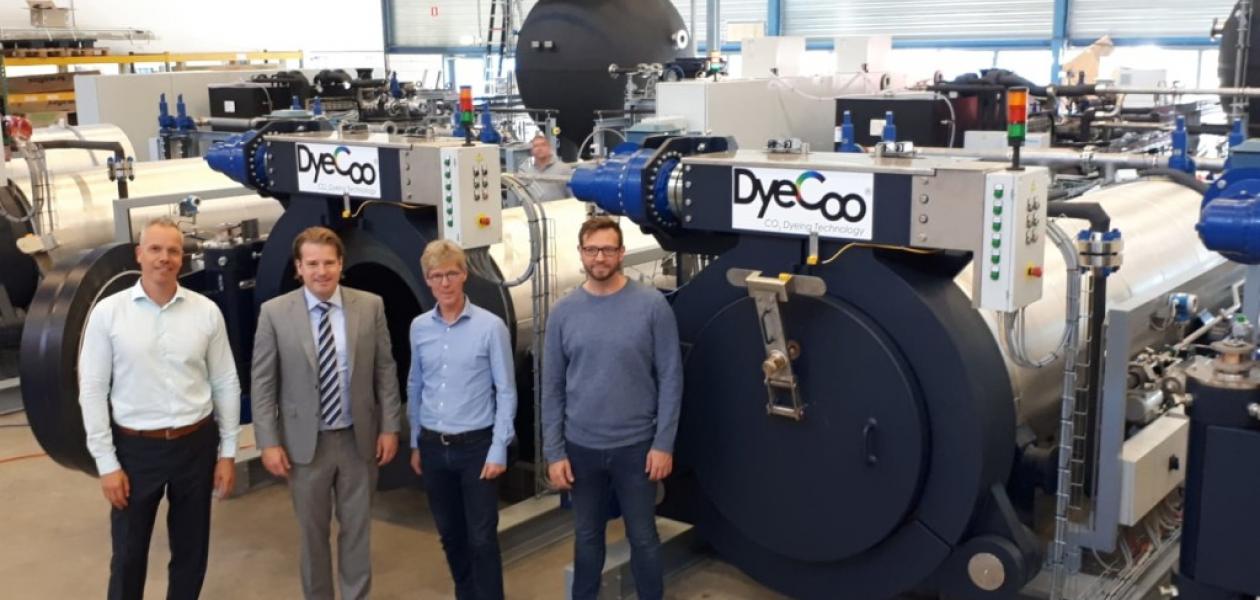VDL ETG Projects assembles a sustainable dyeing machine

Dyeing clothing and shoes with an industrial waste product. DyeCoo Textile Systems has developed a sustainable dyeing machine, the DyeOx. The dyeing machine uses recovered CO2. 95% of this CO2 is reused in the machine. More than 98% of the dye is absorbed by the textile, so hardly any residual waste is created. Because no water is needed during the dyeing process, there is no water pollution. Dyeing textiles with CO2 is energy efficient, and production costs are low. The complete assembly of this innovative machine is done by VDL ETG Projects at the Wekkerstraat location in Eindhoven.
The two DyeOx machines in the VDL ETG Projects production hall make a big impression. Metres-long cylinders with a decimetres-thick cover. A large pressure vessel stands out at the other end of the production line, seen through a construction with pipes and cabling. The large, black, round CO2 drum (sphere) of this machine is produced by VDL KTI. VDL ETG Projects assembles the machine within ten days at DyeCoo’s customer’s location.
Focus
Ernst Siewers co-founded DyeCoo ten years ago. The company has fourteen employees and an annual turnover of almost ten million euros. Ernst Siewers recently met Willem van der Leegte at VDL ETG Projects. “After building the first machines ourselves, we took the step to have our DyeOx assembled by VDL,” says Ernst Siewers. “Why? Professionalism, suitable construction space and the possibility to scale up production of the machines. This will enable us to maintain our focus on further development of the market. Willem’s interest, the enthusiasm of the VDL team and, of course, the manner in which the machines are assembled have proved that VDL is a good choice.”
Sustainable and efficient
Willem van der Leegte: “The use of this sustainable, efficient dyeing machine is very promising. I feel confident this technology will take off, and that the interest from the market will increase considerably.”
Dyeing process
The DyeOx dyes textiles under high pressure. Textiles and dyes are placed in the pressure vessel. The pressure vessel is filled with CO2 from the CO2-storage sphere, the pressure is raised to 250 bar and the temperature is brought to 120 °C. Under these conditions the dye dissolves in the CO2. The CO2 containing the dissolved dye is circulated inside the vessel by a special pump, and the dye penetrates deep into the fibres of the textile. The textile comes out of the machine dry. The entire CO2 dyeing process only takes three hours.
Asia
The first DyeCoo machine was installed in Thailand in 2011. Since then, twelve sustainable DyeCoo dyeing machines have found their way to six different customers in Asia. VDL has built four of them. The two machines that are still at VDL ETG Projects will also find their way to the Asian textile industry. In addition to the textile industry (Nike, Adidas and Mizuno), brands from the automotive, carpet and furniture textile sectors have also expressed interest in this sustainable dyeing machine.

